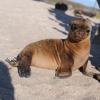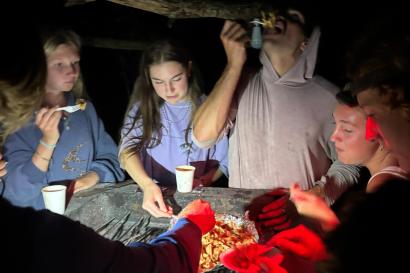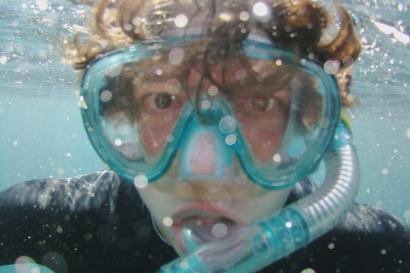When I was really young I thought it was funny how the Zoo in Seattle had an exhibit with the same type of Elk that would wander through my field back home making a nuisance of themselves. They were such a mundane part of life that I couldn’t imagine them being interesting to anyone. Living on these islands for the past three months strolling by sea lions every day on my way to school and shooing away Darwin’s finches as I eat my lunch, I have to wonder if those who grow up here feel the same. Do these islands feel as special as they really are?
Even after just a few weeks living here, Puerto Baquerizo had become for lack of a better word…normal. It’s hard to reconcile my daily life with the fact that I’m living in one of the most famous and important natural places in the world. Yes, I’ve learned to dive, toured the archipelago from the peak of its volcanos to caves beneath the sea, and seen sharks, whales and other unbelievable creatures but these excursions aren’t quite representative of what its really like to live here; some people’s host parents have never even left the island of San Cristóbal. Most of the time life isn’t so different than anywhere else. Days start early, being on the equator the sun comes up consistently at 6 and the town rises with it. Students in an array of uniforms hustle in every direction through the streets on their way to the various schools. Every day I go to class within a ten-minute walk of where Charles Darwin first stepped foot in these islands, but the opposite way down the street is my favorite bakery and the tienda that sells chocolate covered bananas and it feels just like any other little town.
Sea lions lounge on the beach and boats bob in the harbor. There are yellow water taxis, big fast looking tour boats, and fishing boats some of which are already missing at dawn. Often there’s a sailboat, a big catamaran that some foreigners probably sailed here to tour the islands. The Navy’s corvettes are stationed in the same spots as always, they never seem to go anywhere. What they do is unclear. Further out a luxury cruise ship perches on the horizon. From their upper decks the passengers have a panorama of the little town. Their view is sufficient; they and their money will never touch the island. Finally, a huge cargo ship, the islands’ lifeline to the mainland, is usually anchored in the harbor as well. Everyone who travels here is aware of the fragility of the natural ecosystems of these islands, but the lives of its human population are precarious as well. The settlements here rely almost entirely on the mainland for their food.
Despite the mythos that’s been built around the Galápagos this place is not a paradise. As a conservationist I’m worried about the future of the islands as the population grows when even after a few weeks I found it hard to remember what it means to be here. The land here is poor, and farming is inadequate to meet the demands of the population; objectively these islands aren’t really fit for human habitation. When the cargo ships sink there is little to eat but rice. There are many who agitate for greater development to attract more tourists, but this will only compound the problem of food security.
Also, in contrast with its public image there’s quite a lot of trash around town and despite being a tourist destination most people live modest lifestyles. In many ways it just reminds me of my own hometown. Puerto Baquerizo is of course on an island much farther away from any major anything than where I live but the bored teenagers, convoluted local politics, and mild distrust of those politicians from the big city are all familiar. Much like small town USA the dynamics and challenges of living in a small isolated community are not necessarily aligned with the ideals of conservation that the rest of the world attributes to these islands. Despite being the ultimate source of the tourism, which so much of the local economy is built on, the national park is often viewed as a force of the central government wielding its power over the archipelago’s residents.
All this being said there is no doubt that San Cristóbal is somewhere special. Head through the Navy base, down the dirt path, past the cemetery, and there will be surfers and sea turtles sharing the waves at Tongo Reef. The balance between humans and nature in the Galápagos hasn’t been perfected yet, but the progress which has been made is impressive and has the potential to serve as a model for communities around the world. Going for a quick swim and being surrounded by tropical fish or sunbathing with a sea lion on one side and a marine iguana on the other is a clear reminder that this isn’t like other towns. Problems here aren’t so different than those anyone else is struggling with; they’re just under more scrutiny because people have decided to care about this place. The imperfections jump out because Galápagos is imagined to be pristine. Even with its flaws the way people live side by side with the wildlife here is inspirational. Life here may just feel normal but it’s the best kind of normal.

Xavaar Quaranto
<p>I grew up in Eatonville, a small town in Washington just outside the entrance to Mount Ranier National Park, but I moved to Seattle two years ago for college. There's a lot more to do in the city than back home; I've taken dance lessons, played clarinet in a campus band, and this summer I learned how to sail. Exposure to nature here is limited though. I used to go hike in the national park after work, but now I feel like I hardly leave the library! In the Galápagos I plan to spend plenty of time outside both on land and sea.</p>








